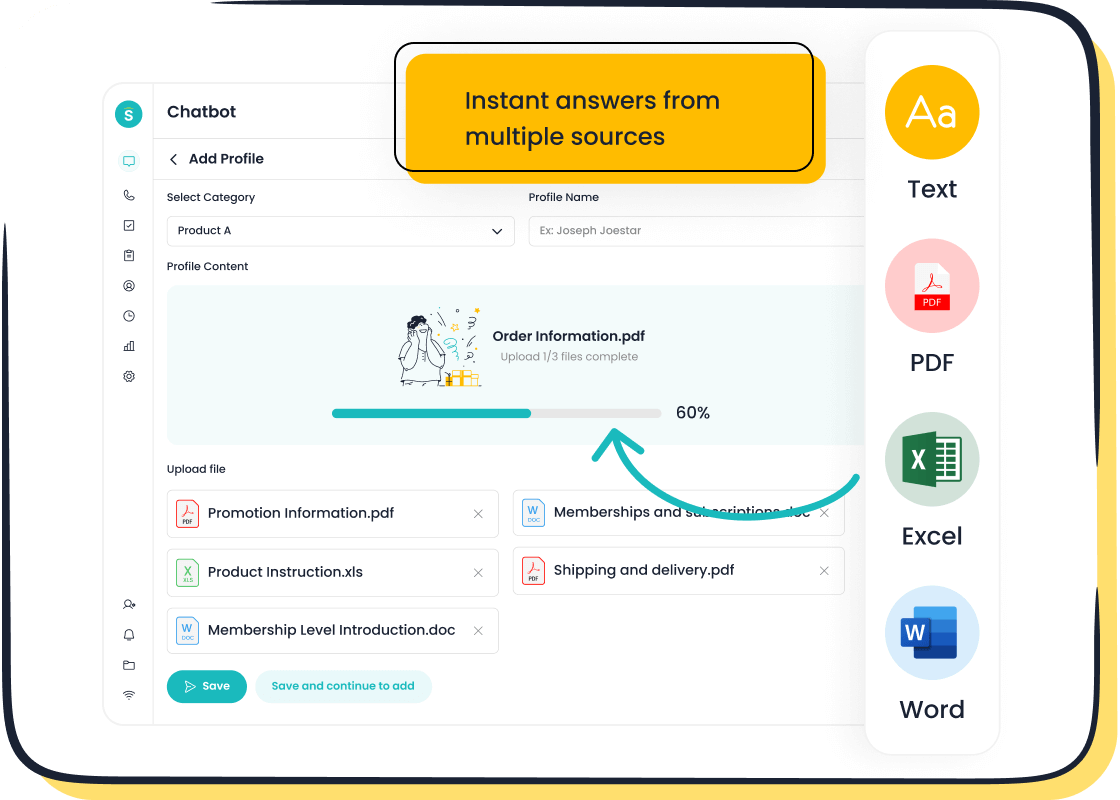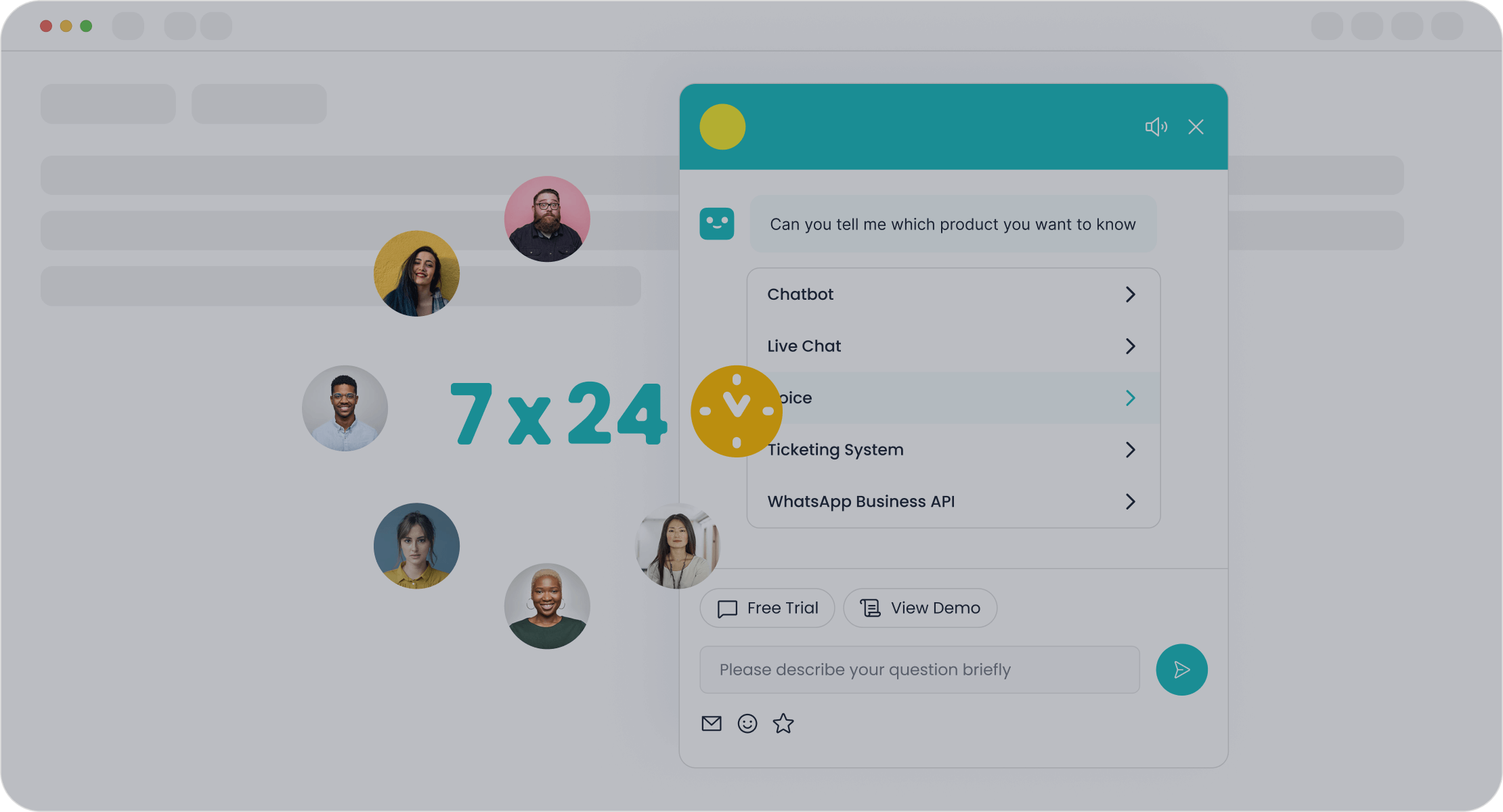Machine Learning vs Artificial Intelligence Key Differences

Artificial intelligence is all about creating systems that mimic human intelligence. It focuses on tasks like decision-making, problem-solving, and automating processes. Machine Learning (ML), a subset of AI, takes this a step further by enabling systems to learn and improve from data over time. Understanding the difference between these two is crucial, especially in customer service. For instance, companies use ML to offer multilingual support, breaking language barriers. AI chatbots, like Sobot’s, handle up to 50% of queries instantly, reducing agent workload and speeding up resolutions. This knowledge helps businesses deliver smarter, faster, and more personalized experiences.
What is Artificial Intelligence (AI)?
Artificial intelligence, or AI, is all about creating machines that can think and act like humans. It’s not just about mimicking human behavior but also about solving problems, making decisions, and automating tasks. AI technologies aim to make your life easier by handling complex processes with speed and precision.
Definition and Goals of AI
AI focuses on simulating human intelligence in machines. It enables systems to perform tasks that typically require human thinking. These tasks include problem-solving, decision-making, and even planning. For example, AI powers dynamic pricing systems like those used by Uber, adjusting prices in real-time based on demand. It also drives autonomous vehicles, helping them make split-second decisions on the road.
The ultimate goal of AI is to create systems that can learn and adapt. This means they don’t just follow pre-set instructions but improve over time. Whether it’s a smart grid optimizing electricity distribution or a chatbot like Sobot’s assisting customers 24/7, AI is designed to enhance efficiency and accuracy.
Types of AI
AI comes in three main types:
- Narrow AI: This is the most common type. It’s designed for specific tasks, like facial recognition or virtual assistants such as Sobot’s Chatbot. These systems excel at what they do but can’t perform tasks outside their programming.
- General AI: This is still theoretical. It refers to AI that can perform any intellectual task a human can. Companies like Microsoft are investing in this area, but it’s far from reality.
- Super AI: This is a future concept. It envisions machines surpassing human intelligence, capable of independent decision-making. While exciting, it’s purely hypothetical for now.
Capabilities of AI in Customer Service
AI is transforming customer service in remarkable ways:

- Natural Language Processing (NLP): AI-powered chatbots use NLP to understand and respond to customer queries. For instance, Sobot’s Chatbot can analyze customer intent and provide instant, accurate replies in multiple languages.
- Predictive Analytics: AI helps businesses anticipate customer needs. By analyzing past interactions, it can suggest solutions before issues arise, enhancing customer satisfaction.
- Automation of Repetitive Tasks: AI takes over routine tasks like ticket generation and FAQ handling. Companies like OPPO have used Sobot’s AI solutions to achieve an 83% chatbot resolution rate, freeing up human agents for more complex issues.
AI technologies are not just tools; they’re game-changers. They help businesses like yours deliver faster, smarter, and more personalized customer experiences.
What is Machine Learning (ML)?
Machine learning (ML) is a fascinating branch of artificial intelligence that focuses on teaching computers to learn from data. Instead of following fixed instructions, ML systems analyze patterns, adapt, and improve over time. This ability makes them incredibly powerful for tasks like predictions, pattern recognition, and automation.
Definition and Goals of ML
ML is all about creating algorithms and models that allow computers to learn autonomously. These systems process data, identify patterns, and make decisions without constant human intervention. For example, ML technologies power tools like voice recognition systems, which adapt to your speech patterns to improve accuracy over time.
The primary goals of ML include:
- Recognizing patterns in data, such as identifying customer preferences.
- Making accurate predictions, like forecasting product demand.
- Automating repetitive tasks, freeing up your time for more strategic work.
Types of Machine Learning
ML comes in three main types, each with unique applications:
- Supervised Learning: This type uses labeled data to predict outcomes. For instance, it can analyze customer churn by identifying behaviors that lead to cancellations.
- Unsupervised Learning: Here, the system works with unlabeled data to find hidden patterns. A great example is clustering customer queries to improve email marketing campaigns.
- Reinforcement Learning: This involves learning through rewards and penalties. It’s perfect for optimizing chatbot responses, ensuring customers get the best possible answers.
Core Components of ML
ML systems rely on several key components to function effectively. Let’s break them down:
| Component | Description |
|---|---|
| Representation | Defines how knowledge is represented in the model. |
| Evaluation | Determines how models are assessed for quality. |
| Optimization | Involves the process of generating effective models. |
Additionally, ML systems require high-quality datasets and robust algorithms. For example, Sobot’s Chatbot uses neural networks to analyze customer queries and provide accurate, multilingual responses. These algorithms continuously learn from interactions, improving their performance over time.
ML technologies are transforming industries by making processes smarter and more efficient. Whether it’s predicting customer needs or automating routine tasks, ML is a game-changer for businesses like yours.
How Are AI and ML Related?
ML as a Subset of AI
ML provides the learning capability within AI systems.

Machine Learning (ML) plays a crucial role in making Artificial Intelligence (AI) systems smarter. Think of AI as the big picture and ML as one of its most important tools. While AI focuses on mimicking human intelligence, ML gives AI the ability to learn and improve from data. For example, Sobot’s AI Chatbot uses ML algorithms to analyze customer queries and provide accurate responses. Over time, it learns from interactions, becoming more efficient and precise. This learning capability is what makes AI systems adaptable and effective in real-world applications.
AI encompasses broader technologies beyond ML.
AI isn’t just about ML. It also includes technologies like Natural Language Processing (NLP), robotics, and computer vision. These technologies work together to create systems that can think, reason, and act intelligently. For instance, Sobot’s omnichannel solutions combine AI-driven chatbots with NLP to deliver seamless customer experiences. While ML focuses on learning from data, AI uses this learning along with other technologies to solve complex problems, like automating customer support or predicting user behavior.
Key Overlaps and Differences
Overlap: Both aim to automate tasks and improve efficiency.
AI and ML share a common goal: making your life easier by automating tasks. Whether it’s an AI-powered chatbot answering customer questions or an ML model predicting product demand, both aim to save time and boost efficiency. For example, ML powers recommendation systems that suggest products you might like, while AI integrates these recommendations into broader systems, like virtual assistants or e-commerce platforms.
Difference: AI focuses on simulating intelligence, while ML focuses on learning from data.
The main difference lies in their scope. AI aims to replicate human intelligence, enabling systems to think, reason, and make decisions. ML, on the other hand, is all about teaching machines to learn from data. For instance, AI might drive an autonomous car, making decisions in real-time, while ML helps the car recognize traffic signs by analyzing thousands of images. AI is the visionary goal, while ML is the practical tool that helps achieve it.
| Artificial Intelligence | Machine Learning |
|---|---|
| AI is a broader field focused on creating systems that mimic human intelligence, including reasoning, decision-making, and problem-solving. | ML is a subset of AI that focuses on teaching machines to learn patterns from data and improve over time without explicit programming. |
| AI systems aim to simulate human intelligence and can perform tasks across multiple domains. | ML focuses on training systems for specific tasks, such as prediction or classification. |
| Examples: Robotics, virtual assistants like Siri, autonomous vehicles, and intelligent chatbots. | Examples: Recommender systems, fraud detection, stock price forecasting, and social media friend suggestions. |
Both AI and ML are transforming industries, especially customer service. By understanding their relationship, you can better leverage these technologies to enhance your business operations.
AI vs ML: A Detailed Comparison
Objectives
AI: Simulate human intelligence and decision-making.
AI focuses on creating systems that can think and act like humans. Its primary goal is to simulate human intelligence and solve complex tasks autonomously. For example, AI powers virtual assistants like Sobot’s Chatbot, which can handle customer queries in multiple languages, mimicking human-like interactions. AI systems aim to function independently, automating tasks that typically require human intelligence, such as decision-making and problem-solving. Whether it’s analyzing customer sentiment or managing dynamic pricing, AI strives to make processes smarter and more efficient.
ML: Learn patterns and make predictions from data.
Machine learning, on the other hand, is all about enabling systems to learn from data. Its main objective is to identify patterns and use them to make accurate predictions or decisions. For instance, ML algorithms can analyze customer behavior to forecast product demand or detect fraud in financial transactions. Unlike AI, which focuses on broader intelligence, ML hones in on improving performance over time without explicit programming. This makes it a powerful tool for tasks like personalized recommendations and predictive analytics.
Technologies and Tools
AI: Includes ML, NLP, robotics, and expert systems.
AI encompasses a wide range of technologies, including natural language processing (NLP), robotics, and expert systems. These tools work together to create intelligent systems capable of handling diverse tasks. For example, Sobot’s omnichannel solutions combine AI-driven chatbots with NLP to deliver seamless customer experiences. AI also integrates robotics for automation and expert systems for decision-making in industries like healthcare and finance. This broad toolkit allows AI to tackle complex challenges across multiple domains.
ML: Focuses on algorithms, data, and model training.
ML relies heavily on algorithms and data to function effectively. Common ML algorithms include linear regression for predicting outcomes, decision trees for classification, and convolutional neural networks (CNNs) for image recognition. For example, Sobot’s Chatbot uses neural networks to analyze customer queries and provide accurate responses. These algorithms are trained on large datasets, enabling the system to improve over time. ML’s focus on data and model training makes it indispensable for tasks like speech recognition and fraud detection.
Requirements and Skills
AI: Requires expertise in multiple fields (e.g., robotics, cognitive science).
Working with AI demands a diverse skill set. You’ll need programming proficiency in languages like Python or Java, a solid understanding of algorithms and data structures, and knowledge of neural networks. Familiarity with AI frameworks, such as TensorFlow, is also essential. Beyond technical skills, creativity and problem-solving abilities are crucial for designing innovative AI solutions. For instance, developing a chatbot like Sobot’s requires expertise in NLP, machine learning, and user experience design.
ML: Requires strong knowledge of data science and statistics.
If you’re diving into ML, a strong foundation in data science and statistics is key. You’ll need to understand concepts like data preprocessing, feature engineering, and statistical modeling. Proficiency in ML frameworks like scikit-learn or Keras is also important. Practical experience with large datasets and ethical considerations in data usage will set you apart. For example, training an ML model for customer segmentation involves analyzing vast amounts of data to identify meaningful patterns. These skills make ML professionals invaluable in today’s data-driven world.
Real-World Applications of AI and ML in Customer Service
Artificial intelligence and machine learning are revolutionizing customer service. Their real-world applications are helping businesses deliver faster, smarter, and more personalized experiences. Let’s explore how these technologies are making a difference.
Applications of AI
Sobot's Chatbot for 24/7 customer support

AI-powered chatbots, like Sobot’s, are transforming how businesses handle customer queries. These chatbots operate 24/7, ensuring customers always get assistance, even outside business hours. By using natural language processing (NLP), they understand customer intent and provide accurate responses instantly. For example, Sobot’s Chatbot can resolve up to 50% of queries autonomously, reducing agent workload and improving efficiency. This not only saves costs but also enhances customer satisfaction by delivering quick solutions.
Virtual assistants for customer engagement
Virtual assistants are another exciting application of AI. Tools like Google Assistant and Siri help customers find information or troubleshoot issues effortlessly. In customer service, virtual assistants engage users by answering questions, scheduling appointments, or even guiding them through complex processes. For instance, Bank of America’s virtual assistant, “Erica,” assists customers with financial planning and transaction tracking, making banking more accessible and user-friendly.
Predictive analytics for customer satisfaction
AI-driven predictive analytics is a game-changer for understanding customer needs. By analyzing past interactions, businesses can anticipate issues and offer proactive solutions. For example, AI tools can detect emotions in customer interactions, helping companies address concerns before they escalate. Predictive analytics also powers recommendation engines, like Amazon’s, which suggest products based on browsing history and past purchases. This personalized approach boosts customer satisfaction and loyalty.
Applications of ML
Personalized recommendations in e-commerce
Machine learning excels at analyzing customer behavior to deliver personalized experiences. For example, Starbucks uses ML to study purchase patterns and recommend tailored promotions. Similarly, e-commerce platforms leverage ML to suggest products you’re likely to buy, enhancing your shopping experience. These personalized recommendations not only improve sales but also make customers feel valued.
Image and speech recognition for customer interactions
ML enhances customer interactions through advanced image and speech recognition. Apple’s Siri, for instance, uses ML to understand voice commands and respond accurately. In customer service, this technology enables chatbots and virtual assistants to interpret user inputs, whether spoken or written. This makes interactions smoother and more intuitive, especially for customers with accessibility needs.
Predictive analytics in call centers
Call centers benefit immensely from ML-powered predictive analytics. By analyzing call data, ML models can forecast customer needs and prioritize issues. This ensures agents focus on high-priority tasks, improving response times and overall efficiency. For example, automated systems can route tickets to the right team, reducing delays and enhancing customer satisfaction.
AI and ML are no longer futuristic concepts. Their real-world applications are helping businesses like yours deliver exceptional customer service. Whether it’s through chatbots, virtual assistants, or predictive analytics, these technologies are reshaping the way companies interact with their customers.
When to Use AI vs ML in Customer Service
When to Use AI
For complex systems requiring multiple technologies (e.g., omnichannel contact centers).
You should consider using AI when your customer service setup involves multiple channels and technologies. AI shines in managing complex systems like omnichannel contact centers, where it can unify communication across platforms such as email, live chat, and social media. For example, Sobot’s AI-powered solutions integrate seamlessly with various channels, ensuring a smooth customer experience. AI doesn’t just connect these systems; it also optimizes them. It can route customer queries to the right department, analyze interactions in real-time, and even predict customer needs. This level of coordination is hard to achieve without AI, especially when dealing with high volumes of customer interactions.
When simulating human-like decision-making is essential.
AI is your go-to when you need systems that can think and act like humans. Imagine a chatbot that not only answers questions but also understands customer emotions and adjusts its tone accordingly. That’s the power of AI. Sobot’s Chatbot, for instance, uses natural language processing to simulate human-like conversations, making interactions feel personal and engaging. This capability is crucial in scenarios like complaint resolution, where empathy and quick decision-making can make all the difference. AI helps you deliver a human touch at scale, ensuring every customer feels heard and valued.
When to Use ML
For tasks involving large datasets and pattern recognition.
Machine learning is perfect for analyzing massive amounts of data to uncover patterns. If your business collects customer data—like purchase history or support tickets—ML can help you make sense of it. For instance, ML algorithms can identify trends in customer behavior, such as which products are frequently bought together. This insight allows you to offer personalized recommendations, boosting sales and customer satisfaction. Sobot’s Chatbot leverages ML to analyze customer queries and improve its responses over time, ensuring accuracy and relevance.
When automation and predictions are the primary goals.
If your main objective is to automate tasks or make predictions, ML is the way to go. It excels at tasks like forecasting call volumes or predicting customer churn. These predictions help you allocate resources effectively and address issues before they escalate. For example, ML can analyze historical data to predict when your support team will be busiest, allowing you to schedule agents accordingly. Sobot’s solutions use ML to automate repetitive tasks like ticket categorization, freeing up your team to focus on more strategic work.
Understanding the differences between Artificial Intelligence (AI) and Machine Learning (ML) is essential for making informed decisions in customer service. While AI focuses on simulating human intelligence, ML specializes in learning from data to make predictions. Here’s a quick comparison to help you grasp their distinctions:
| Aspect | AI Description | ML Description |
|---|---|---|
| Scope | Broad field aiming to simulate human intelligence | Subset of AI focusing on data learning and predictions |
| Functionality | Performs various tasks like calls and inventory management | Excels at processing data and making predictions |
| Methods | Uses techniques to mimic human actions | Relies on algorithms to find patterns in data |
| Example Systems | Includes virtual assistants and smart devices | Includes models for data analysis and decision-making |
Recognizing these differences helps you choose the right tools for your business. For example, Sobot’s AI Chatbot combines the strengths of both AI and ML to deliver personalized, efficient customer interactions. By leveraging these technologies, you can:
- Improve customer engagement and satisfaction.
- Optimize operations and reduce costs.
- Make smarter, data-driven decisions.
When you understand how AI and ML complement each other, you unlock their full potential to transform your customer service strategies.
FAQ
What is the difference between AI and ML in simple terms?
AI focuses on creating systems that mimic human intelligence, like decision-making or problem-solving. ML, a subset of AI, teaches machines to learn from data and improve over time. For example, AI powers virtual assistants, while ML helps them recognize speech patterns for better responses.
How does machine learning improve healthcare diagnostics?
Machine learning analyzes medical data to identify patterns and predict diseases. For instance, ML models can detect early signs of cancer from imaging data. This improves healthcare diagnostics by making them faster and more accurate, saving lives and reducing costs.
Can AI and ML work together in customer service?
Yes! AI and ML complement each other. AI chatbots, like Sobot’s, use ML to analyze customer data and improve responses. This combination automates repetitive tasks, predicts customer needs, and delivers personalized support, enhancing efficiency and satisfaction.
What kind of data is essential for machine learning?
High-quality, diverse data is crucial for ML. For example, in healthcare, patient records, imaging data, and lab results train models for diagnostics. In customer service, chat logs and feedback help ML systems improve interactions and predict customer behavior.
Are AI and ML used outside of customer service and healthcare?
Absolutely! AI and ML are everywhere. They power recommendation systems in e-commerce, optimize logistics, and even enhance entertainment platforms like Netflix. In healthcare diagnostics or customer service, these technologies transform industries by automating tasks and improving decision-making.
See Also
Navigating Artificial Intelligence Solutions for Call Centers
Evaluating AI Solutions for Enterprise Call Centers
Best 10 AI Tools for Enterprise Contact Centers
